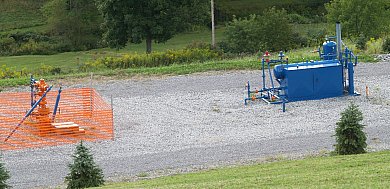Marcellus Shale: Pennsylvania targets natural gas drilling boom with new regulations
Wednesday, December 22, 2010

HARRISBURG, Pa. — While Marcellus Shale natural gas drilling may just be getting started in Ohio, Pennsylvania has been dealing with it for a couple of years. So, it is no surprise that a movement is under way to establish tougher regulations in the Keystone State.
Two new regulations were passed for the entire state in 2010.
New regulation:
In July, a regulation enacted by the Pa. Department of Environmental Protection, requires natural gas drilling companies to treat drilling wastewater to the safe drinking water standard for Total Dissolved Solids, or TDS, including chlorides and sulfates.
The new regulation ensures the state’s streams do not exceed the safe drinking water standard of 500 milligrams per liter.
Another new regulation mandates a 150-foot buffer for the 20,000 miles of Pennsylvania streams that are the state’s most pristine and highest quality.
In November, the Independent Regulatory Review Commission unanimously approved new regulations that require best well design and construction practices that will include measures to prevent gas migration which can contaminate water supplies or cause health and safety concerns in homes.
Delaware watershed
Meanwhile, the Delaware River Basin Commission is working to establish regulations governing water withdrawals for natural gas drilling throughout the watershed, as well as how operations develop wells and manage wastewater.
The Delaware River Basin Commission (DRBC) includes the areas of Delaware, New Jersey, eastern Pennsylvania and portions of New York.
The rules are only proposals at this time and are now open for public comment. The comment period ends March 16, but the public hearings are yet to be scheduled.
Water source regulation
If finalized, the commission will require that water used for natural gas development projects come from water sources that have been approved by the commission for use for natural gas development.
The proposal permits water sources located within the physical boundaries of an approved natural gas development plan to be approved for uses in the natural gas drilling process. These regulations also permit flowback and production waters, treated wastewater and mine drainage water to be reused for natural gas development under specified conditions.
Well pad siting
Due to the risk the water resources face from well pad construction and operation, the watershed commission is also considering regulations for where well pads are placed.
It would develop well pad siting and planning requirements, including requiring preparation of natural gas development plans by companies that have total lease holdings in the Delaware River Basin of over 3,200 acres or that intend to construct more than five natural gas well pads designed for any type of natural gas well.
The plans identify geographic and hydrological constraints to natural gas development.
There are also proposed restrictions regarding siting in flood hazard areas, or on steep slopes and areas that serves as critical habitat for federal or state designated threatened and endangered species.
The watershed proposal includes a requirement for pre- and post project monitoring of surface and groundwater near well pads involving high volume hydraulically fractured wells.
Well construction, operation
The commission wants to require that all non-domestic wastewater be transferred to appropriate tanks for temporary storage on the well pad site or to a centralized wastewater storage facility and that fluids and drill cuttings from horizontal wellbores be reused or disposed of at an appropriate waste facility.
Wastewater
The plans call for any wastewater treatment facility within the basin may accept non-domestic wastewater from a natural gas development project only if the facility first obtains approval from the commission.
To gain authorization, a project must submit a treatability study to also demonstrate that it will not exceed surface water to be used as a public water supply, or damage stream quality.
The regulations also include a tracking system for disposal of wastewater.
Financial assurance
The watershed commission would also require financial assurance for the plugging, abandonment and restoration of natural gas wells and the remediation of any pollution from natural gas development activities in the amount of $125,000 per gas well.
After well installation and hydraulic fracking are complete, then a reduction in the financial requirements may be granted if there is no harm to the environment.
For other information and stories related to marcellus shale drilling, check out these links:
Marcellus Shale Gas Leasing: Consult your lawyer and get it in writing Sept. 19, 2010
http://www.farmanddairy.com/news/marcellus-shale-gas-leasing-consult-your-lawyer-and-get-it-in-writing-2/15756.html
Marcellus shale drilling: Can safe water supply be sustained? Sept. 24, 2010
http://www.farmanddairy.com/uncategorized/marcellus-shale-drilling-can-safe-water-supply-be-sustained/15808.html
Marcellus Shale drilling: Sifting through the good and the bad Sept. 30, 2010
http://www.farmanddairy.com/news/marcellus-shale-drilling-sifting-through-the-good-and-the-bad/15834.html




